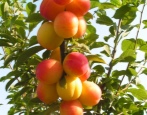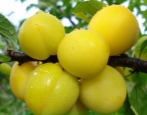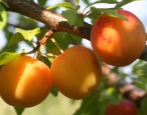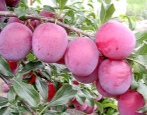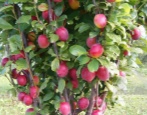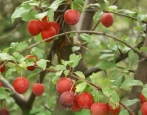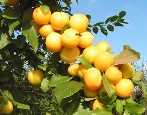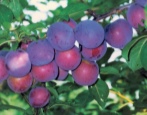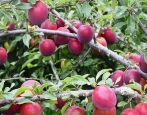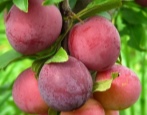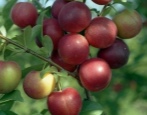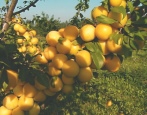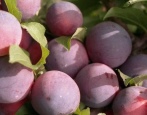
- Name synonyms: Prunus cerasifera Soneika
- Appeared when crossing: Mara x pollen mixture of diploid plum varieties
- Growth type: undersized
- Ripening period: mid-early
- Self-fertility: self-infertile
- Fruit size: very large
- Yield: high
- Appointment: for fresh consumption
- Fruit weight, g: 45
- Fruit shape: rounded
Cherry plum Soneyka will come in handy on the farm for many, many gardeners. But this attractive variety must be applied skillfully. And for that - to collect the most complete and reliable information about its properties.
Breeding history
It should be pointed out right away that this variety does not appear in the State Register at all. According to information from the suppliers of the planting material, it was obtained by hybridization. The starting points were cultivar Mara and a combination of pollen from a number of diploid plums. The official name of the plant is Prunus cerasifera Soneika.
Description of the variety
Sonya is not too tall cherry plum. Its trunks rise up to a maximum of 3 m. The flat-round crown seems to droop. It is of medium density. The light green foliage is oval in shape. Leaves are usually elongated.
The bending of the sheet is characteristic in the manner of a boat. The tip is sharpened. The perimeter of the sheet plates has a wavy contour. The flowers are white.
Fruit characteristics
Cherry plum Soneyka gives very large drupes weighing up to 45 g. They are round and mostly colored in a light green tone. But gradually the fruit turns yellow, and soon, in a ripe state, it is distinguished by a pure yellow color. The stone is medium in size. Unfortunately, it will not work to separate it from the soft part of the drupe.
Taste qualities
Soneika's yellow flesh reaches medium density. It is always juicy. A characteristic feature of the plant is its sweet and sour taste. The aroma is present, but it will not be particularly strong. Tasting examination gives this variety an average mark of 4.5 points.
Ripening and fruiting
Cherry plum of this type begins to delight gardeners with drupes, usually 2 or 3 years after planting. It is necessary to expect the appearance of flowers in early May (in normal weather). In terms of maturity, this is a mid-early variety. You can count on harvesting at the end of August. Of course, depending on the conditions of a particular year, all the indicated dates can be greatly shifted.
Yield
The productivity level of this variety is quite high. It can reach 25 tons per hectare with plantation cultivation. Ordinary farmers and gardeners also have the right to count on a decent result. But much depends on the weather, and on the efforts of the land owners themselves.
Growing regions
Soneyka can be successfully bred in central Russia. This culture is recommended for all lands in Belarus. Therefore, it is permissible to assume that everywhere in regions with a milder climate, it will also give a good result. But it is hardly worth relying on successful cultivation in more complex localities in terms of general conditions.
Self-fertility and the need for pollinators
The variety is self-fertile, and when planting bushes, only this type of crop can not be expected. Plum varieties bred in Eastern Europe are suitable as pollinators. And also the varieties Altai Jubilee and Alyonushka can be used for this purpose.
Growing and care
Watering should be done in moderation. However, sometimes - in the case of unproductive sands and sandy loams - it should be activated. The same rule applies during particularly hot periods.It is advised to dig up the landing site since the fall. The main preparation of the site for work begins in March.
The pit for Soneika should be 600x700 mm. All the weeds are being pulled out nearby. If possible, you should choose sunny areas. It is inappropriate to plant such a crop near sheds and other structures that shade the planting. Soil fertility must be guaranteed - both through the selection and application of fertilizers. It is imperative to avoid areas flooded in spring or autumn.
The planted cherry plum Soneyka is watered with 5 liters of water at once, in which mineral fertilizers are dissolved. Young trees are watered twice a week using 10 liters of water. In dry moments, watering is intensified - but up to a maximum of 3 times a week and no more than 15-20 liters of water per intake. Excessive irrigation leads to root rot and can even destroy the culture. In addition to spring feeding, fertilizers are applied twice more - in the middle and at the very end of summer.
From organic matter, humus is best suited. Of the minerals for Soneika, the most attractive are compositions containing phosphorus and potassium. Croning is done twice a year, getting rid of dry and damaged shoots. When the crop is harvested, the crown is thinned out, thereby achieving high quality fruits for the next year. The layer of organic mulch around the trunk should be 7 to 10 cm.
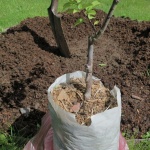
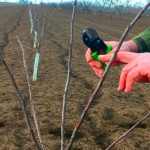
Disease and pest resistance
Resistance to pathologies and harmful insects is above average. The immunity is especially high in relation to clasterosporium disease. Protection measures against other diseases and pests should be taken only when there is a clear threat of injury. For example, if suitable weather conditions were created, or plants in other areas began to hurt en masse.

Requirements for soil and climatic conditions
Soneyka does not have any special requirements for the soil. This non-capricious plant can thrive even on gray forest soil or in areas rich in gravel. Sandy, sandy loam lands with low botanical productivity are also suitable for it. It should be noted that the variety is sun-loving. But at the same time, like many plants, it can suffer from light burns.
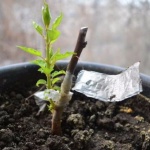
Review overview
In the assessments of gardeners, first of all, the compactness of such a culture is noted, which is excellent for small gardens. There are no reasons to complain about the yield. The taste of the harvested fruits is also pleasing. The appearance meets all the main product criteria. The harvested crop is excellent not only for your own use, but also for sale.

